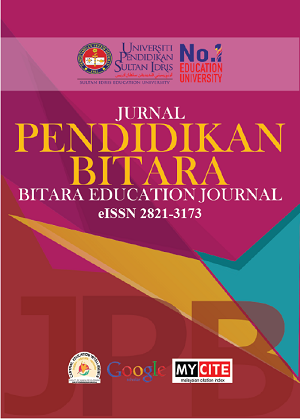Loganathan and Sivakumar’s Baum Test: A Psychodiagnostic Tool to Identify Internet Addiction
DOI:
https://doi.org/10.37134/bitara.vol15.1.1.2022Keywords:
Internet addiction, Tree test, Projective test, Baum test, PsychologyAbstract
The objective of this study is to examine the prevalence of internet addiction in urban secondary schools and the impact on school discipline problems and academic performance. A qualitative research design was used to identify internet addiction through a non-verbal projective test. Purposive sampling was used to select ten F4 students as respondents. The respondents had to own smart handphones or laptops and must have access to the internet. The non-verbal projective test used was Loganathan and Sivakumar’s Baum Test (LSBT). LSBT required the respondents to draw four fruit-bearing trees and the drawings were interpreted by using hermeneutic science. The findings of the LSBT showed 90% of the respondents had mild to severe internet addiction. The LSBT projective test provided more in-depth information as it accesses the unconscious mind. In addition, the respondents have no control over their tree drawings as their unconscious mind is being projected on the paper. In conclusion, this study proposes that the LSBT can be used to identify internet addiction. A questionnaire was used to obtain information on the respondents’ usage of the internet. The findings of the questionnaire showed that all the respondents owned smartphones and had easy uncontrolled access to the internet. The school records showed that none of the respondents had discipline problems in school. The academic records showed that 80% of the respondents had obtained excellent results in their examination. Thus, there was no negative impact on school discipline and academic performance. The implication of this study is internet addiction can be identified early and intervention can be done to help those who are addicted to the internet. The study has provided a new insight into students who habitually use excessive internet. Teachers can use this information to encourage the use of the internet in a positive manner. School counsellors can use the LSBT to get a better understanding of the students’ discipline problems so that they can be counselled and advised correctly.
Downloads
References
Abdul Aziz, M., Wan Ismail, W., Bahar, N., Mahadevan, R., & Azhar Shah, S. (2018). Internet Addiction among Secondary School Students in Klang Valley, Malaysia: What is the Association with Depressive Symptoms, Anxiety Symptoms, and Self-Esteem? The International Medical Journal of Malaysia, 17(2), 17–26. Retrieved from http://iiumedic.net/imjm/v1/download/volume_17_no_2/original/Vol17No2-017-026.pdf
Awaluddin, S. M. B., Ying Ying, C., Yoep, N., Paiwai, F., Lodz, N. A., Muhammad, E. N., … Nik Abd Rashid, N. R. (2019). The Association of Internet Addiction and Perceived Parental Protective Factors Among Malaysian Adolescents. Asia-Pacific Journal of Public Health, 31(8_suppl), 57S-64S. https://doi.org/10.1177/1010539519872642
Carlisle, K. L., Carlisle, R. M., Polychronopoulos, G. B., Goodman-Scott, E., & Kirk-Jenkins, A. (2016). Exploring Internet Addiction as a Process Addiction. Journal of Mental Health Counseling, 38(2), 170–182. https://doi.org/10.17744/mehc.38.2.07
Eichenberg, C., Schott, M., Decker, O., & Sindelar, B. (2017). Attachment style and internet addiction: An online survey. Journal of Medical Internet Research, 19(5), 1–9. https://doi.org/10.2196/jmir.6694
Karaer, Y., & Akdemir, D. (2019). Parenting styles, perceived social support and emotion regulation in adolescents with internet addiction. Comprehensive Psychiatry, 92, 22–27. https://doi.org/10.1016/j.comppsych.2019.03.003
Koch, C. (1952). Der Baumtest. H. Huber
Lieberman, A., & Schroeder, J. (2020). Two social lives: How differences between online and offline interaction influence social outcomes. Current Opinion in Psychology, 31, 16–21. https://doi.org/10.1016/j.copsyc.2019.06.022
Loganthan, K. (1986). New Baum Test : On How To Conduct the Test. Universiti Sains Malaysia. Retrieved from http://ulagank.tripod.com/nbtconduct.htm
Omar, S. Z., Saharuddin, N. F., & Bolong, J. (2019). Measuring Internet Addiction among Multiracial Youths in Malaysia. International Journal of Academic Research in Business and Social Sciences, 9(9), 18–27. https://doi.org/10.6007/IJARBSS/v9-i9/6340
Sivakumar, R. (2015). The Science of Baum Test Agamic Psychology, Level 1. Ulaganaar Agamic Sciences Center
Sivakumar, R. (2015). The Science of Baum Test Agamic Psychology, Level 2. Ulaganaar Agamic Sciences Center
Sivakumar, R. (2015). The Science of Baum Test Agamic Psychology, Level 3. Ulaganaar Agamic Sciences Center
Sivakumar, R. (2015). The Science of Baum Test Agamic Psychology, Level 4. Ulaganaar Agamic Sciences Center
Sivakumar, R. (2015). The Science of Tamilar Agamic Psychology (Baum Test), Power Point Slides Ulaganaar Agamic Sciences Center
Talwar, P., Mohamad, F. S., Mustaffa, M. S., Othman, M. K., Bee, O. Y., & Hian, C. C. (2019). Internet addiction among university students: Psychometric properties of three factor model internet addiction test. Online Journal of Health and Allied Sciences, 18(1).





